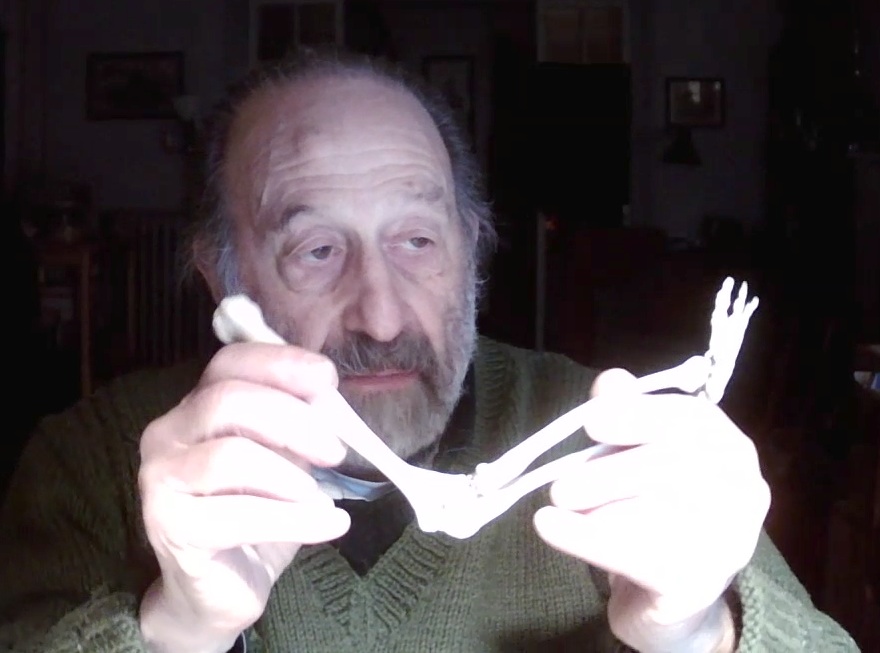
Fig. 1. Video describing the action of armbones in wrist rotation.
Clarifications of Perplexing Taiji Sayings and Admonitions
©Copyright 2021 by Robert Chuckrow
How words are used can reduce confusion or increase it. Precise descriptions can help your understanding and accelerate your progress, and imprecise wording can mislead you. In regard to having an incomplete understanding, the Taiji Classics say, “Missing by a little will lead miles astray,”1 which is also stated as, “If the arrow is aimed slightly off, it will miss the target by a lot.”
Here are some examples of imprecise word usage. Explanations are suggested for what they really mean:
1. Release all tension.
Clarification: Moving any part of the body away from its neutral (equilibrium) configuration creates tension, which is a stress caused by the elastic restoring force of the displaced bodily tissues. So it is impossible to have movement without producing tension. Moving any part of the body by using muscular contraction (instead of passively, as a result of, say, gravity) also produces a much-higher degree of additional tension in the muscles and associated tendons. In doing Taiji, the tension produced by use of muscular contraction is to be avoided, which only can be done by replacing contractive muscular strength with expansive strength (neì jìn, translated as internal strength). Movement by use of expansive strength does produce tension in the tissues as a result of their innate elasticity. However, the additional tension in muscles and tendons that would otherwise be produced by contraction of muscles is absent. Instead of using contractive strength, which cuts off blood and qì, using expansive strength opens the tissues, and the neural electricity that produces its expansive action has a healing benefit.2
2. Don’t use strength.
Clarification: Without any use of strength, the body would be unable to do any movement including that of breathing. Also, as Stanley Israel, who was one of the six top New York City Taiji disciples of my first Taiji teacher, Professor Cheng Man-ch’ing, said, “How could there be a martial art that uses no strength?”
The physiology of muscular action was unknown hundreds of years ago. Nevertheless it was understood that there were three versions of strength, namely lì (brute strength), jìn (refined strength) and nèi jìn (refined, internal strength). My understanding is that li can be taken to mean untrained contractive muscular strength, jìn can be taken to mean trained strength, and nèi jìn can be taken to mean expansive strength. The oft-used admonition not to use strength could have arisen from translations employing modern usage for which the distinction between lì and jìn have since disappeared. So “Don’t use strength” can be taken to mean “Don’t use contractive muscular strength” and certainly does not rule out the use of expansive strength.
3. Sink your elbows.3
Clarification: The word sink suggests that the elbows should remain as low as possible. This admonition is understandable because beginners habitually lift their elbows—and their shoulders. But the elbows are part of the arms. When you raise your arm, your elbow must rise, and when you lower your arm, your elbow must lower. Also, when you rotate your whole arm to thumb-down without twisting your forearm, your elbow rotates upward and away from your body, and the opposite rotation of your arm lowers your elbow and moves it toward your body.
Some Taiji practitioners keep their elbows as low as possible. One problem in doing so is that raising a hand without the natural movement of the elbow restricts the bending and swiveling movement of the shoulder joint and requires bending the elbow joint inordinately. Additionally, many Taiji movements involve a 180-degree rotation of a wrist. Preventing the natural movement of the elbow in fully rotating a wrist necessitates a full 180° swiveling of the elbow and forearm joints (e. g., “Rollback and Press”). But the maximum rotation of the wrist from its neutral orientation by the use of expansive strength (nèi jìn) is only about 90° (45° in each direction from neutral). So keeping the elbow fixed when rotating the wrist 180° prevents an additional possible 90° of rotation of the arm and necessitates the use of contractive strength in the muscles of the forearm. Click this link or the picture in Fig. 1, below, to view a video explaining the action of the arm bones.

Fig. 1. Video describing the action of armbones in wrist rotation.
So the hinge actions of the shoulder and elbow joints, the swiveling of the shoulder joint, and the swiveling of the elbow and forearm joints should all work together naturally, in a coordinated manner. As the Taiji Classics say, “Remember, when moving, there is no place that doesn’t move,”4 which implies that all parts of the body should participate appropriately and naturally in each movement. By including an appropriate degree of rotation of the upper arm when rotating the wrist, the required amount of forearm rotation can remain within the limit for using expansive strength, thus eliminating the need for resorting to contractive strength.
The relaxed rotations of the wrists promote the flow of qì by their gentle stretching of the tissues and acupuncture meridians. So turning the forearms excessively reduces the health benefits. Also, strength is maximized by an optimal shape of the arm and is reduced when free movement is prevented. Finally, the purpose of wrist rotations in a self-defense modality is to combine the turning of the trunk of the body with that of the wrist (“The wrist is the second waist”) whether rolling your partner or opponent off (neutralizing) or rolling your arm into the opponent’s space (attacking). Including a rotation of the upper arm thereby increases the rolling effect more naturally whereas over-rotating the forearm, which requires contractive strength, alerts your partner or opponent, and therefore, is less effective.
In both the health and self-defense modalities, rotating the wrists solely from the forearms without the motion of the upper arms is unnatural and less efficient. Thus, there are good reasons for not restricting the movement of the elbows. The fact that Yang Cheng-fu said, “In Ward Off the two arms should be rounded as if propped up”5 implies that sink does not mean keeping the elbows at their lowest position.
Yang Zhenduo, son of Yang Cheng-fu, talks about the Yang-style’s Twenty-Character Motto: “Extend the elbows outward; leave a hollow in the armpits. The elbows pull down the tops of the shoulders, connect the wrists and carry along the fingers.”6As the wrists rotate, the joints of shoulders, elbows, and wrists coordinate their actions to maximize the unification of the arm and, consequently, maximize the nèi jìn and qi in the arms. With each movement of an arm, the elbow should be as relaxed as possible and rise and lower as a result of the unified movement of the upper arms and forearms.
Watch Wang Shu Jin doing Taiji movement during the first 3 minutes of this video. Note the beautiful coordination of movement of upper and lower arms with Wang’s wrist rotations in both of these videos. Here is another video of Wang taking punches to his abdomen.
Caution: When rotating the arm upward and outward, be careful that the shoulder doesn’t tense and rise.
4. Shift your weight.
Clarification: The net effect of the gravitational force on all of the particles of an object can be considered to act at the body’s balance point. That point (which changes with movement) is called the center of gravity (here equivalent to center of mass). When the center of gravity of your body is directly over the center of one foot, your body is balanced. When your body shifts, it is similarly balanced when your center of gravity is directly over the line from the center of one foot to that of the other (but not beyond those centers). So “shift your weight” means shifting your center of gravity. To ensure your continuing to be balanced, the shifting is along the line joining the centers of your two feet.
5. Sink your weight.
Clarification: The weight of anything that has mass is the gravitational force exerted by the Earth on it. Your weight is the gravitational force exerted by the Earth on your body. The direction of that force is downward toward the center of the Earth, and its magnitude is simply called “your weight.” Because there is nothing you can do internally to change either the magnitude or direction of the force of gravity on you, “sinking your weight” is technically meaningless. Lowering your center of gravity, however, is meaningful and can be done in two ways. One way is to bend your knees more. Doing so will lower your center of gravity but not necessarily in the intended manner. The other way is to release contractive muscular strength to the degree that tissues within the body lower, muscle-group-by-muscle-group—and even cell-by-cell. This latter lowering is internal and doesn’t involve any external lowering of the body.
6. 100% of your weight is on one foot.
Clarification: When you are balanced and your center of gravity is directly over one foot, the floor exerts an upward force on that foot, thus balancing the force of gravity on your body. That upward force is equal in magnitude to your weight. By Newton’s third law, your foot exerts a downward force on the floor that is equal in magnitude to your weight.7
It follows that the force of the other foot on the floor is equal to zero. By Newton’s third law, the force of the floor on that foot is also equal to zero.
7. Imagine your weight to be 6 ft. below the floor.
Clarification: This concept appears to be scientifically meaningless but may be helpful to some practitioners. Scientifically, it can only mean arranging your center of gravity to be below your body, which is impossible. The above image can be interpreted to mean that when your partner tries to disrupt your balance by pushing you, you then relax and liquefy your body completely. Then you arrange forces on your partner to simulate the sensation that the majority of your body mass is so far below the ground that the force required to move you would be equivalent to that to move a vertical stick, pivoted at ground level, with a mass equal to that of your entire body six feet below the pivot point.
It would seem that the only way such an image could bear fruit would be to use nei jin as follows: When the other person pushes you, his force is directed to what he perceives as best to move your actual center of gravity. By Newton’s third law, your body automatically exerts an equal and opposite force on him. However, by some means, you then exert an additional force on him, which, by Newton’s third law, causes his body to automatically exert an equal and opposite force on you in a way that strengthens your root. The sum of the two forces on him is then equivalent to what he would feel if your center of gravity were 6 ft. below ground level.8
8. Suspend the top of your head.
Clarification: Suspending the head implies supporting it from above as if by a cord. Such an arrangement can certainly be imagined but is less likely to provide an understanding of the desired internal state than visualizing the anatomical manner of actuation, directly experiencing it and its effect, locking in the feeling, and then recreating that state over time.
The head is enclosed in bone and, therefore has no ability to move on its own, so extending your head upward on its own is impossible. The head rests on the Atlas, which is the top vertebra of the spine. The way to lift the top of your head is to extend the Atlas upward by expanding the surrounding tissues of the vertebrae of the neck. This action is of great value for improving posture and unleashing the flow of qi.
9. Imagine a heavy weight pulling your tailbone downward.
Clarification: The correct alignment is achieved internally by releasing your lower spine and extending it downward by using expansive strength to separate its vertebrae. Extending the top and bottom vertebrae of your spine oppositely may not produce much movement but can beneficially reduce the intervertebral pressure throughout the whole spine. Doing so is of great value and also improves posture.
10. Imagine a weight hanging from your chin.
Clarification: The front part of the head is lighter than the back part because the empty space of the mouth and nasal passages is in front. Therefore, the center of gravity of the head is more toward the rear, which allows that point of the head to balance on the top vertebra (Atlas). To locate that point, place the tips of your forefingers on the bony protrusions behind your earlobes. The midpoint of the line joining your fingertips is where your head rests on the Atlas of your spine.
We live in a world that induces our heads and chins to jut forward. Rather than offsetting that tendency by holding your head in a preconceived orientation using your analytical mind and ongoing contractive strength, it is better to relax the muscles of the head and neck and then feel the head balanced on the Atlas. Awareness of that state is more consistent with the Taiji principles than using an image of a weight hanging from the chin. Here is a link to an exercise for freeing up the neck muscles that I was taught by Elaine Summers, with whom I studied Kinetic Awareness® (KA).
11. Don’t twist the trunk of the body.
Clarification: Twisting the trunk means turning the upper part of the trunk through a different number of degrees than that of its lower part. Nothing exists that is incapable of twisting because such a thing would be totally rigid. But in Taiji, we must liquefy the whole body and avoid rigidity. So the body must be capable of twisting. The meaning of above admonition not to twist the body is not to actively twist the body. Beginners—and even some more advanced practitioners—tend to actively turn their shoulders more than their pelvises, thereby producing a larger movement of their arms than they otherwise would be able to achieve were all their bodily parts unified. Such active twisting is an error. However, when the lower body turns and then stops, the upper part of the trunk has rotational (angular) momentum and, therefore, continues to turn until the stretching of bodily tissues on one side and the compression those on the other side bring it to a stop. Such passive twisting is a beneficial form of massage and the precursor to what is called spiraling qi (discussed next). It seems that the fa jin (energy release) of the martial striking in Taiji involves the creation of an internal torsional (twisting) wave moving up from the feet, through the body, and then out through the arms in a whip-like manner (see the following video showing a Torsional wave). In the linked video, the wave travels with approximately the same energy and then is reflected. In the body, however, the energy of the torsional wave incereases as it rises as a result of acitvation by means of nèi jìn, and the wave has accumulated a lot of energy by the time it reaches the arm.
It should be added that in neutralizing, the body moves more as a unit, but in striking there is more of an internal wave. In doing the form, one chooses the degree of bodily play.
12. Spiraling qi.
Clarification: A spiral (Fig. 2) is two-dimensional.
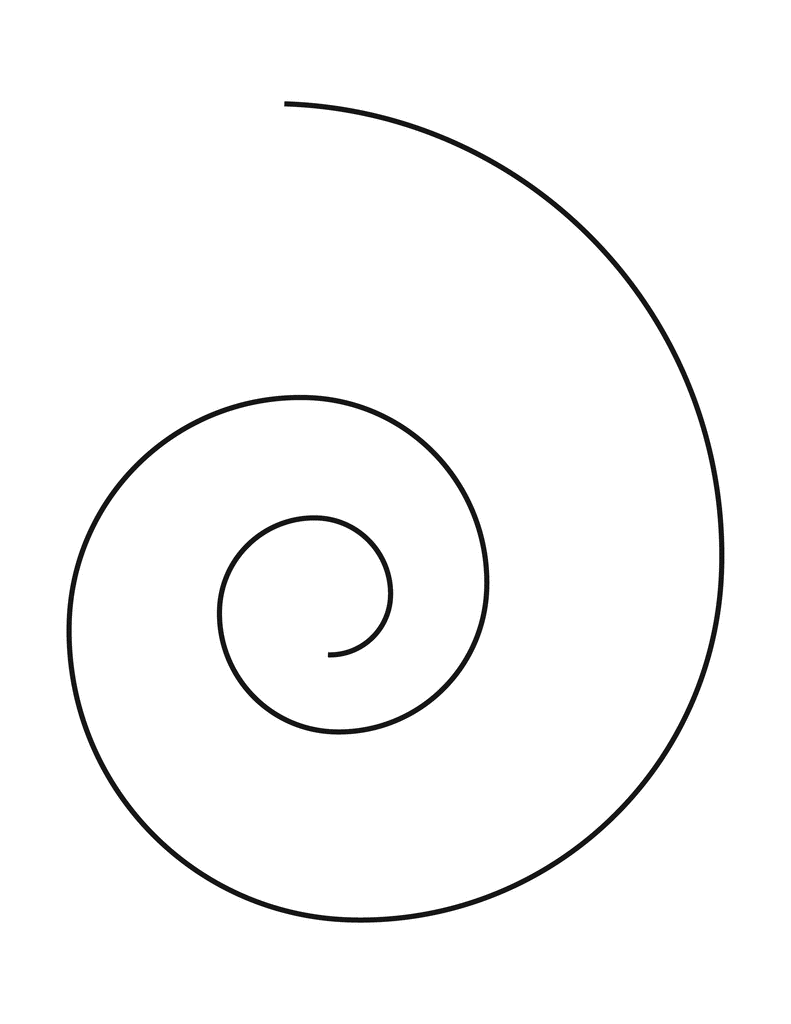
Fig. 2. A spiral.
How can a two-dimensional concept accurately describe what’s really happening in a three-dimensional body? Perhaps a replacement for the above term might be torsional wave (see link in the previous clarification)—or maybe helical qi (Fig. 3).
.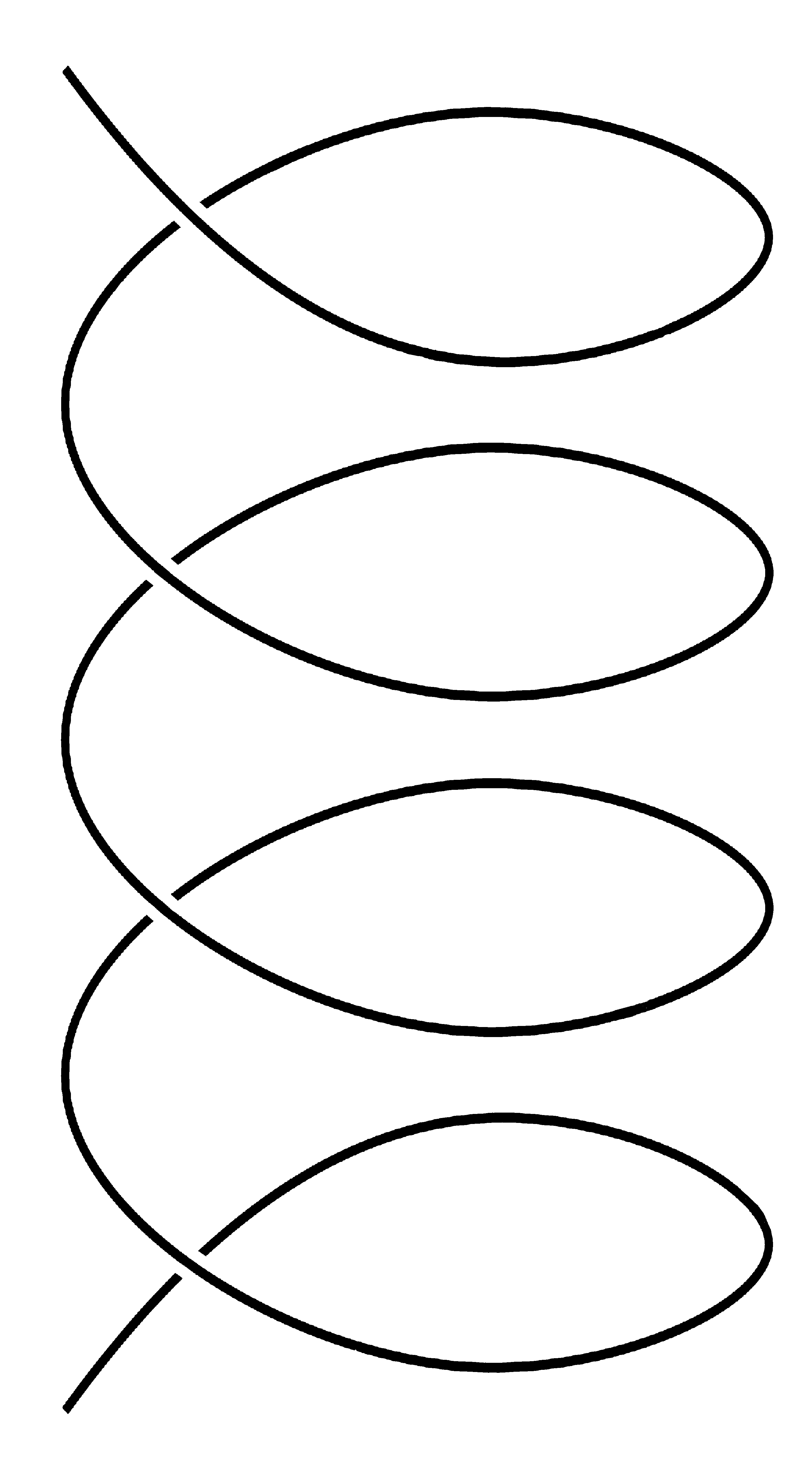
Fig. 3. A helix.
13. The head doesn’t turn.
Clarification: First it is necessary to specify the frame of reference relative to which the turning does or does not occur. The head can turn or remain stationary relative to the trunk of your body or relative to the Earth. In doing Taiji movement, the head is always turning relative to the Earth, so we can assume that this admonition means, “The head doesn’t turn relative to the trunk of your body,” or the nose and navel always line up.
Please keep in mind that for all final postures, whether 70-30 or 100% ones, the nose points in the direction of the stance, that is, in the direction of the forward foot. For 100% stances in the Yang style, the angle of the rear foot relative to the direction of the stance has varied over time. The current version uses 45º and the older version (typical of the Cheng Man-ch’ing style) uses 90º. It will be shown that the admonition holds for the current version but not always for the older one.
In both versions, the nose and navel continually line up when doing a succession of alternating left and right 70-30 postures (e. g., “Brush Knee”). In 100% postures, when the rear foot is at a 45º angle relative to the direction of the forward foot (Fig. 4), the nose and navel both can point in the direction of the stance. But in 100% stances, where the rear foot points 90º to the direction of the forward foot (Fig. 5), the nose and navel must point in different directions.
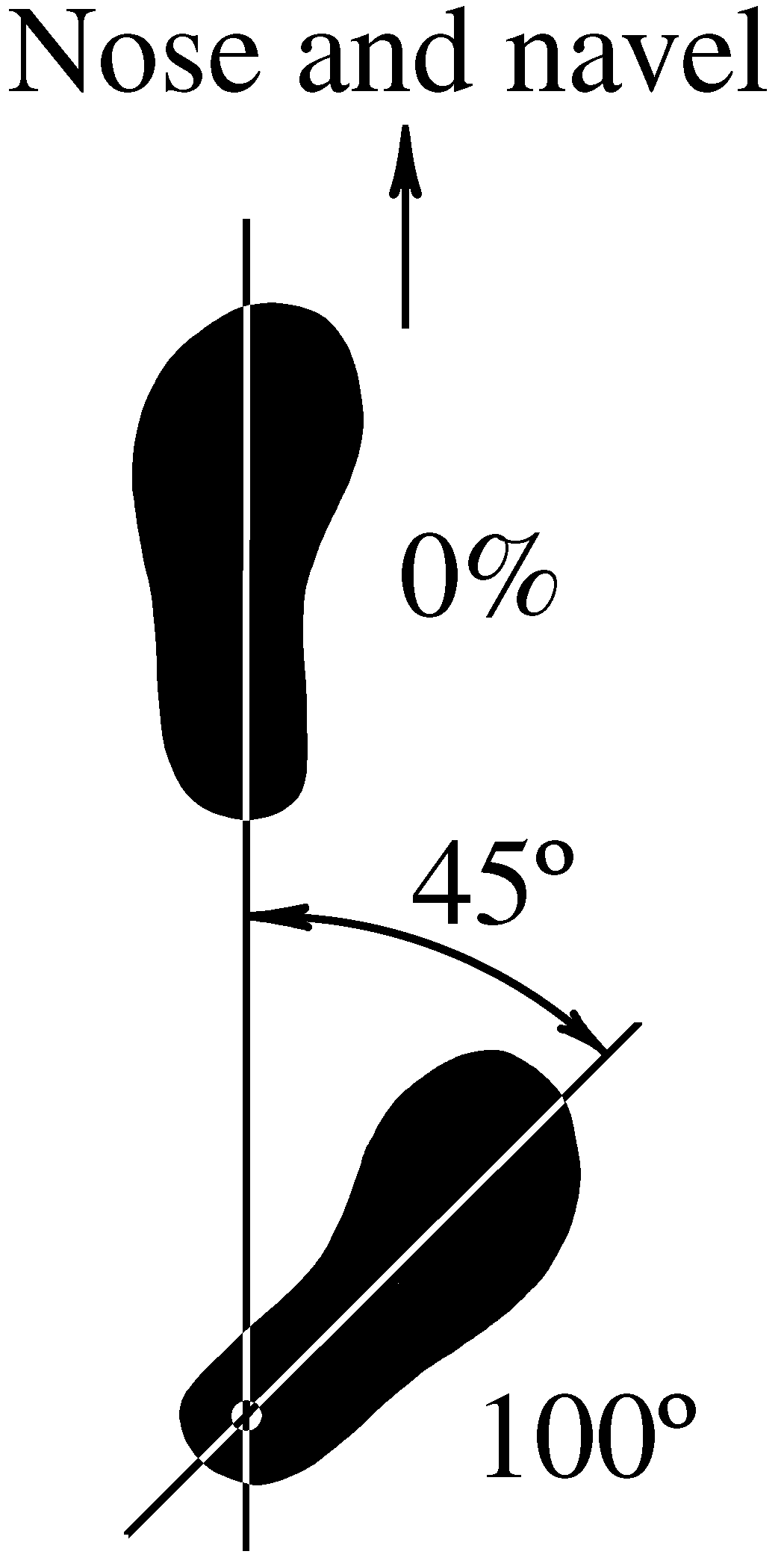
Fig. 4. 100% stance with feet at 45º.
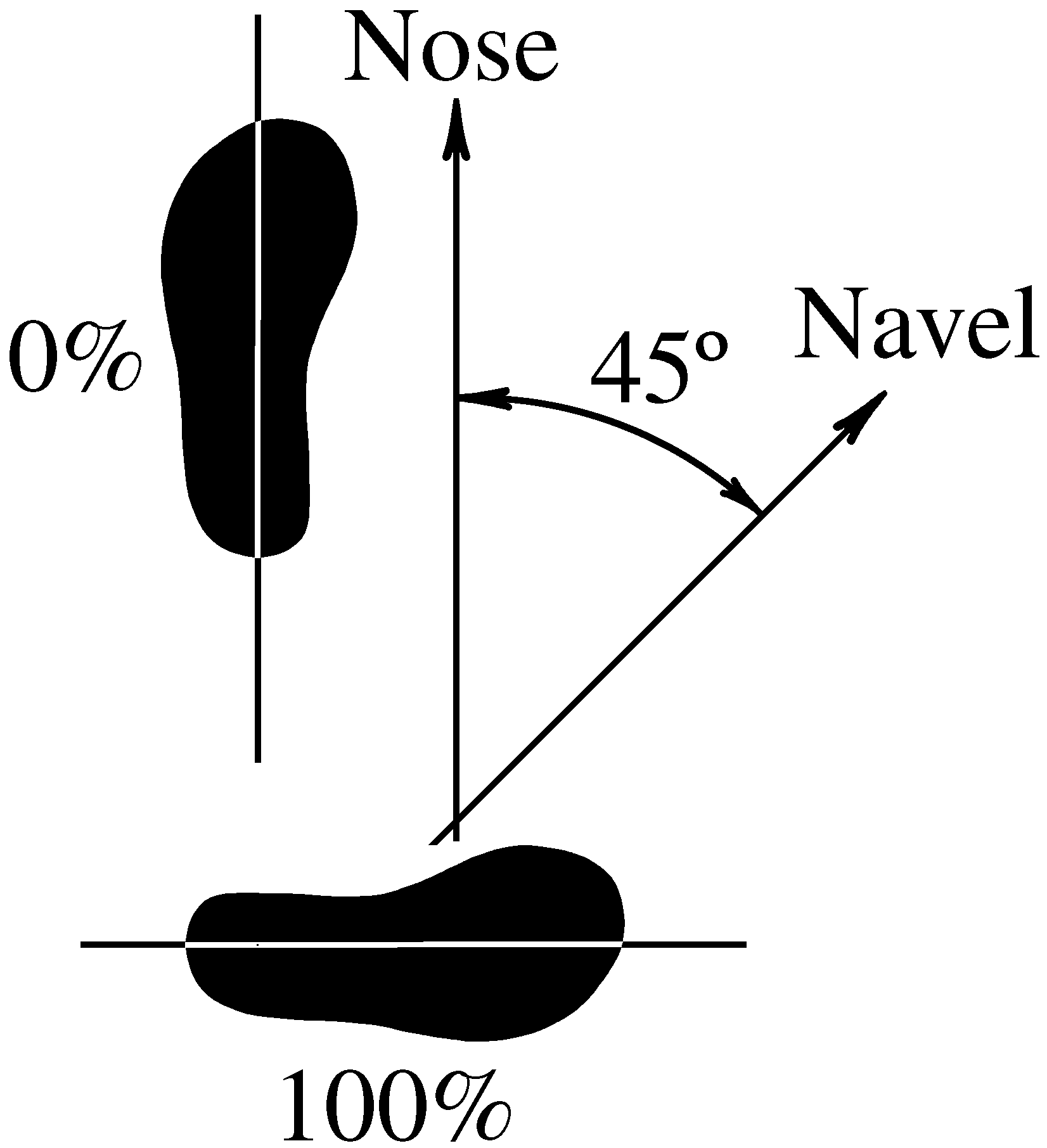
Fig. 5. 100% stance with feet at 90º.
The reason for nose and navel not lining up in 100% postures in the older version is that it is physiologically impossible for the body to turn 90º relative to the direction of the rear foot. Thus the navel points approximately midway between the direction of the forward and rear feet, which are 90º apart. So in transitioning from a 70-30 stance to a 100º one, the body turns about 45º, but the head turns 90º, 45º more than did the body.
So what is probably intended by saying, “the head doesn’t turn” is that when the head does turn relative to the body, it should do so appropriately and continuously, with a relaxed neck, and through the use of nèi jìn.
14. Extension and contraction, opening and closing, should be natural.9
Clarification: Extending is an outward movement that in Taiji movement requires exertion of internal strength (nèi jìn). Therefore, extension is yáng. The complement of a yáng action should be a yin one. But contraction implies pulling inward by muscular contraction, which is yáng. Therefore, extension and contraction is yáng and yáng, which violates a basic Taiji principle of balancing and alternating yin and yáng. Also contracting is antithetical to the concept of releasing all contractive strength. Expansion (nèi jìn) stretches bodily tissues, which are elastic. Releasing nèi jìn is yin, and the restoring force produced by the elasticity of the tissues allows them to return closer to their neutral state. A more-descriptive use of words than extension and contraction would be expanding and condensing,10 which implies a balance and alternation of yin and yáng and suggests the correct yin aspect of releasing nèi jìn.
15. Empty/Full, Yin/Yang Paradox11
Clarification:
In Taiji, we refer to the 100%-weighted leg as full and the other, suspended leg as empty. By empty, we mean empty of any support of bodily weight. By full, we mean that the full weight of the body is supported by that leg. A test of whether a leg is empty or not is to put the foot in question on a piece of thin paper. If another person can easily withdraw the paper without any resistance, then that leg is empty.
More than once in Taiji discussions, the characterization of a foot as being empty has led to a perplexing discussion of yin and yáng. It goes like this: The empty foot in a 100% stance exerts no pressure on the floor. The fully weighted foot is supportive, earthy, inactive, and, therefore, yin. The empty foot is potentially ready to step or kick in an upward, outward, expansive action. Thus, the empty foot is yáng. However, if something is empty (insubstantial), one would think it is yin— not yáng. To resolve this seeming contradiction, consider the following examples:
Imagine two balloons, one empty (inactive, yielding, lying down, soft) and the other one full of hot air (expansive, convex, firm, hot. upward). Clearly, the empty one would be yin, and the full one would be yáng. By contrast, consider two buckets, one empty, the other one full of ice water (heavy, cold). In this case, the empty bucket would be yang compared to the one that is full.
Thus, if we say something is empty—or any other characteristic—we can’t say whether it is yin or yáng without knowing the underlying conditions. Empty can be either yin or yáng, and the context and meaning are the determining factors. When it is said that a foot is empty, it just means that it exerts no pressure on the floor and that it is potentially active and ready to step or kick (“motor running”), which is yáng, not yin.
Another possible reason for confusion is that a 100%-weighted leg involves stretching of the quadriceps and involves a high degree of tension. That tension is not active but passive— from totally releasing contraction and giving in to gravity. There is, however, a dot of yáng in the yin, namely an upward expansion (in Taiji, nothing should ever be completely yin or yáng).
16. A force of 100 lb is deflected by 4 ounces.12
Clarification:13
What is meant by this saying is that a very powerful attack can be deflected with a very small force. Whereas its concept is very important, its wording leads to misunderstanding in explanations involving physics because it is inconsistent with Newton’s third law. Namely, if A exerts a force on B, then B must exert an equal and opposite force on A. So if there is a force of 1,000 pounds, it must be exerted on something (or somebody) that (or who) exerts 1,000 pounds back. Here, the force that the opponent exerts would be on you, and of course, you would exert an equal-and-opposite force back on him.
But the main idea is not to interact with the opponent in a way that can cause injury to yourself. The goal is to exert minimal force on the opponent and arrange that his attack clears your body. Using minimal force on the opponent means that you don’t need a lot of strength. It also means that he will, by Newton’s third law, use minimum force on you, which lessens the chance that you will be injured. Interfering minimally with the opponent’s motion means that he will feel that he is not being thwarted, continue his motion, be more likely to over-extend, and as a result, lose his balance. Then, he will either fall or pull back. If he pulls back, you can easily push or hit him.
Physics-wise, it is simply incorrect for an attack to be described in terms of an opponent’s “incoming force,” and therefore, it is incorrect to analyze the neutralization in such terms. Maybe the opponent intends to exert 1,000 pounds of force on you, but he is unable to do so because of how you arrange the conditions.
Whereas it is inappropriate to talk about an incoming force, it is necessary to treat the force exerted by the defender to understand the conditions for minimizing that force (see A Clarification of “Secret” Teachings Revealed by Cheng Man-ch’ing).
1The Essence of T’ai Chi Ch’uan, The Literary Tradition, Edited by Benjamin Pang-jeng Lo, North Atlantic Books, Berkeley, CA, 1985, p. 40.
2For an in-depth treatment of expansive strength, see Chapter 2 of Robert Chuckrow, Tai Chi Concepts and Experiments: Hidden Strength, Natural Movement, and Timing, YMAA Publcation Center, Wolfeboro, NH, 2021.
3T’ai Chi Touchstones: Yang Family Secret Transmissions, Compiled and translated by Douglas Wile, Sweet Ch’i Press, Brooklyn, NY, 1983, p. 27.
4The Essence of T’ai Chi Ch’uan, The Literary Tradition, pp. 57.
5T’ai Chi Touchstones: Yang Family Secret Transmissions, p. 65.
6https://2009.yangfamilytaichi.com/articles/yang-style-tai-chi-chuan-twenty-character-motto/
.7The downward force of gravity is equal and opposite to the upward force of the floor on your foot, but these forces are not an action-and-reaction pair. In an action and reaction pair, he following three requirements always hold: (a) Both forces are never on the same object. (b) Both forces are of the same type (gravitational, electrical, or nuclear). And (c) the elimination of one force in the pair automatically eliminates the other. Thus the downward force of gravity and the upward force of the floor on your foot are not an action-reaction pair because: (a) The force of the Earth on your body and the force of the floor on your foot are both forces on your body. (b) The force of the Earth on your body is gravitational, but the force of the floor on your foot is electrical. (c) If the floor dropped away, the force of the floor on your foot would disappear, but the gravitational force of the Earth on you (your weight) would remain as you plummeted downward.
8See my article on an analysis of Rooting and Redirecting.
9The Essence of T’ai Chi Ch’uan, The Literary Tradition,Translated by Benjamin Pang Jen Lo et. al., North Atlantic Books, Berkeley, CA, 1985, pp. 57, 65.
10The words expanding and condensing were frequently used by one of my main teachers, Sam Chin Fan-siong.
11From Robert Chuckrow, Tai Chi Concepts and Experiments: Hidden Strength and Natural Movement, YMAA Publication Center, Inc., PO Box 480, Wolfeboro, NH 03894, 2020, p. 112.
12The Essence of T’ai Chi Ch’uan, The Literary Tradition, p. 37.
13From Robert Chuckrow, Tai Chi Concepts and Experiments: Hidden Strength and Natural Movement, p. 152.